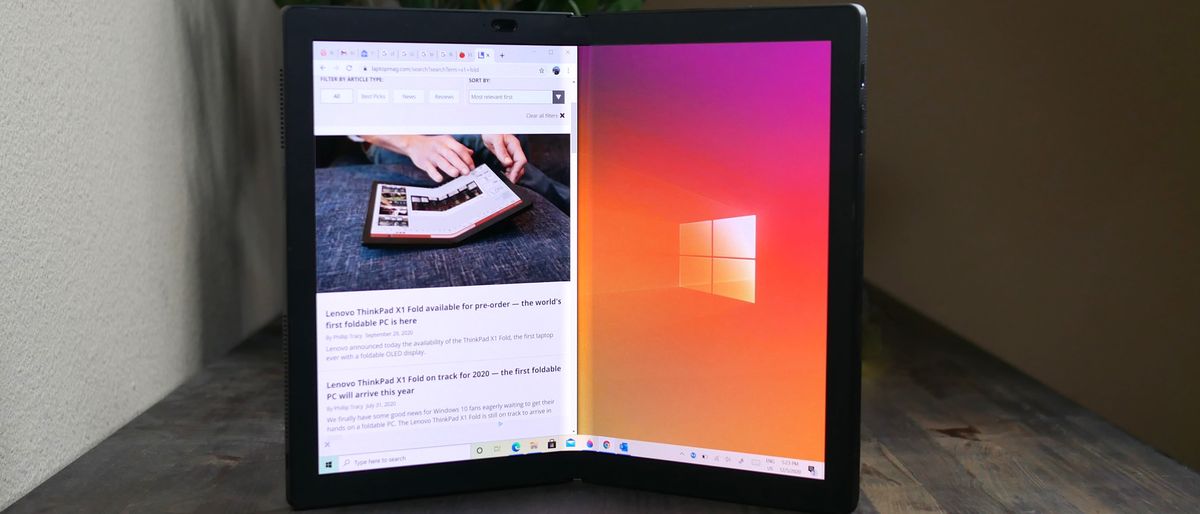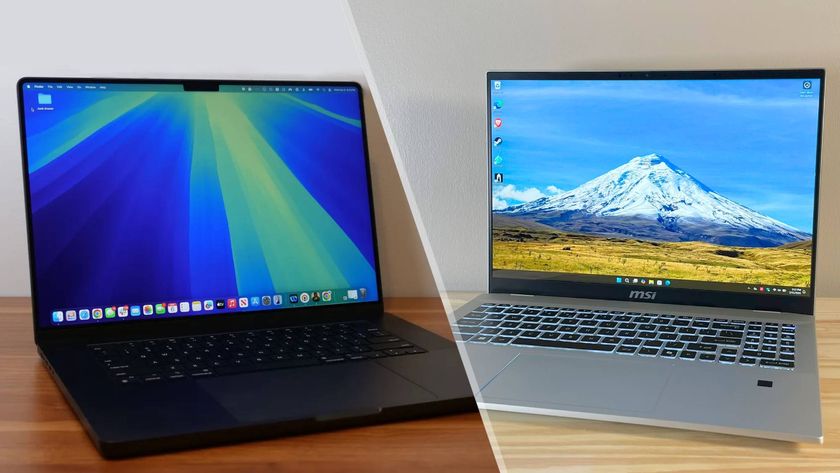Laptop Mag Verdict
The ThinkPad X1 Fold, the world's first foldable PC, ushers in a new era of computing
Pros
- +
Truly innovative design
- +
Luxurious, durable materials
- +
Superb build quality
- +
Breathtaking flexible OLED display
- +
Supports stylus and a clever mini keyboard
Cons
- -
Poor battery life
- -
Middling performance
- -
Some annoying software quirks
- -
It costs $2,500 without the accessories
Why you can trust Laptop Mag
Price: $2,499 (starting); $2,799 (reviewed at)
CPU: Intel Core i5-L16G7
RAM: 8GB
Storage: 256GB
Display: 13.3-inch, 2048 x 1536-pixel
Battery: 6:03
Size: 11.8 x 9.3 x 0.45 inches (unfolded); 6.2 x 9.3 x 1.1 inches (folded)
Weight: 2.2 pounds
Sorry Lenovo, you proved me wrong. I didn't expect to see the X1 Fold this year. Heck, I even doubted a 2021 launch. There were good reasons for my suspicions. Microsoft indefinitely delayed Window 10X, the OS we expected the X1 Fold to run. Then COVID-19 happened and supply chains suffered. And let's not forget the backlash Samsung faced after the Galaxy Fold debacle.
And yet, here I am, staring at a breathtaking flexible OLED display housed within what can be best described as a fancy leather notebook. No, Lenovo didn't need extra time to craft this novel device — the build quality of this flexible tablet is exquisite, the display is stunning, and the keyboard and stylus accessories work reasonably well.
But like most first-generation products, the X1 Fold needs refining before I can recommend it. Perhaps its biggest offense (besides the price) is the poor battery life. Combine that with sub-par performance and frustrating bugs and it's hard to envision using this flexible 2-in-1 as a day-to-day device. Then we get to the price: $2,500 without any of the accessories. That speaks for itself — the X1 Fold is made for the elite and eager early adopters, who I suspect will fall in love with it. For everyone else, save some money and stick with one of the best 2-in-1 laptops.
Lenovo ThinkPad X1 Fold price and configurations
Before I get into the numbers, remember that this the first of its kind, the potential start of a new era. OK, enough of that — the X1 Fold is very expensive. The base model costs — hold onto your wallets — $2,500 and comes with an Intel Core i5-L16G7 CPU, 8GB of RAM and a 256GB SSD.
For $2,749, you get the same config bundled with the Mod Pen (stylus) and Fold Mini Bluetooth keyboard. An extra $50 upgrade gets you our review unit, which runs Windows 10 Pro instead of Windows 10 Home.
The only other upgrade available is expanded storage; a 512GB SSD brings the price to $2,899 while a 1TB SSD model goes for $3,099.
Lenovo ThinkPad X1 Fold design
Notebook by day, tablet by night. The ThinkPad X1 Fold looks like something from a luxury stationery store from the outside. Crack the cover open and your eyes are treated to a gorgeous 13-inch flexible OLED display.
If you've ever owned a fancy notebook — maybe a Moleskine or Leuchtturm — then you know how satisfying they are to hold. Think about the sumptuous leather on those journals then combine it with glass accents and a magnesium alloy frame and you've got the exterior of the ThinkPad X1 Fold.
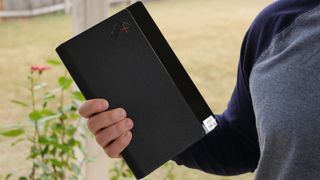
Imprinted in the leather cover is a familiar ThinkPad X1 logo, lacking only the illuminated "i". On the front is a thin glass panel; when the X1 Fold is opened, the leather from the spine stretches to cover that glossy surface. The black glass is a clever design element that adds a touch of class to the tablet when closed and vanishes so you can enjoy a fully leather back in tablet mode. It's a beautiful combination of materials and the fit and finish is superb.
That said, the real magic happens when you open the X1 Fold to find a flexible OLED display. When unfolded, the flat screen is 13.3 inches, or the size of a typical portable laptop panel. Bordering the screen are thick bezels, kept chunky in order to protect the display and give you something to grip in tablet mode. The soft-touch rubber material Lenovo used for the borders is a nice touch.
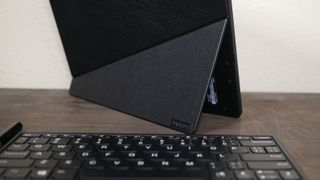
On the rear of the X1 Fold is a kickstand, enabled by a hinge that runs diagonally along the back cover. Prying your finger between the leather and metal opens the flap, revealing a plush red felt on the inside of the kickstand. The stand is stiff enough to hold the tablet in both vertical and horizontal orientations, but lapability is a major issue.
By that, I mean that the X1 Fold isn't practical to use on any non-flat surface. The tablet will wobble or sit off-kilter on your lap or any uneven furniture, like a couch. We have this same problem with the Surface Pro series although the kickstand on those models is better at balancing the screen.
The best way to use the X1 Fold on your lap is with the keyboard on the lower half of the X1 Fold and the screen folded in a 90-degree angle, similar to a clamshell laptop. The problem with this method is that your screen real estate gets cut in half, and you need to rely on the undersized accessory.
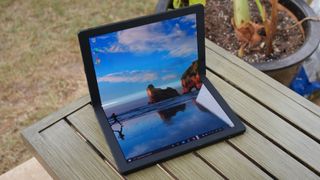
Another issue I have with the X1 Fold is that the area between the screen and bezel, as well as the seam between the bezel and outer frame, collect particles. Those tight areas are difficult to clean and my compulsive self struggled to overlook the grime.
The main benefit of a foldable display is to reduce the footprint of the tablet. The X1 Fold achieves that, measuring 9.3 inches tall and only 6.3 inches wide when folded versus 11.8 inches wide when unfolded.
The downside? The X1 Fold is thick. At 2.2 pounds and 0.5 inches in tablet mode, the Fold is already thicker than the Apple's iPad Pro (12.9-inch) (11 x 8.4 x 0.2 inches, 1.4 pounds), the Microsoft Surface Pro 7 (11.5 x 7.9 x 0.3 inches, 1.7 pounds, and the Dell XPS 13 (11.6 x 7.8 x 0.6 inches, 2.8 pounds). Close the notebook and the thickness goes to 1.1 inches, or gaming laptop territory.
Lenovo ThinkPad X1 Fold durability
The ThinkPad promise of military-grade durability remains uncompromised. Despite being a first-gen product, the X1 Fold survived 12 MIL-STD-810G-rated tests. In layman's terms, this thing can take a punch.
I'm really impressed by the build quality of this foldable device, especially after seeing other failed first-attempts at making foldables. The X1 Fold was silent when I opened and closed it — no creaking, cracking or other cringe-inducing noises, only the sweet snapping sound when the two halves meet.
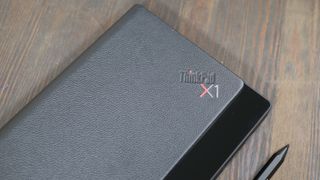
Opening the device reveals an engineer's dream — the mechanisms found within seem capable of launching a spacecraft. After testing six different designs, Lenovo landed on a multi-link torque hinge mechanism that manages stress when you fold the PC. Keeping the screen from permanently creasing or scratching are carbon-fiber-reinforced plates that have gone through "extensive durability testing" to ensure the tablet can withstand hard taps and even drops.
It's clear Lenovo didn't just make the world's first folding PC reliable, it made it down-right durable. If Samsung had put as much painstaking detail into the first Galaxy Fold, maybe foldables wouldn't have had such a rocky start.
Lenovo ThinkPad X1 Fold ports
There are two USB-C ports on the X1 Fold. One is located on the bottom of the front cover, or the bottom-left edge when opened.
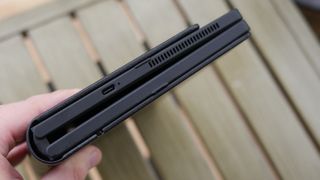
The other USB port is on the right edge of the cover toward the bottom, or the lower-left edge of the tablet when opened and viewed in the horizontal orientation.

An optional SIM card slot is located on the right edge of the front cover below the speaker grille. Unfortunately, there is no headphone jack or SD card reader.
Lenovo ThinkPad X1 Fold display
It's one thing to dazzle at the beauty of an OLED TV from the other side of your living room. It's an entirely different experience to hold this breathtaking display technology in the palm of your hand and interact with it by touch.
I've been using the X1 Fold for about a week and everything I've watched on the 13-inch, 2048 x 1536-pixel flexible OLED display has blown me away. Cheering on FC Bayern against Atletico Madrid in a UCL game was quite the experience; I felt like I was holding the pitch in my hand. Windows 10 icons and graphics burst from the screen with vivid colors and text looked crisp even when zoomed in.
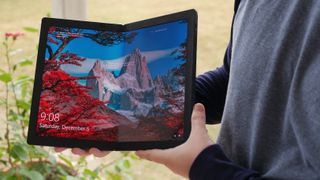
Now, about the crease. It does exist. It has to otherwise the plastic will permanently fold. But because the multi-link hinge keeps the OLED screen perfectly flat, the crease is so subtle that I never noticed it when the pixels beneath illuminated. Put the X1 Fold to sleep and you'll spot two lines running vertically up to the screen where they fold at the spine.
Crease or not, the screen is absolutely mesmerizing. The Lasso of Truth pierced my corneas as it zipped across the screen like a golden lightning bolt in the trailer for Wonder Woman 1984. The superhero's red chrome armor was as vibrant as a freshly painted car while the pastel blues and pinks in a funky t-shirt worn by Chris Pine gave me nostalgia for the fearless fashion of the mid-'80s. The panel is also detailed; I could see individual leaves in miniature trees lining the red carpet at a posh event, and spotted veins bursting from Gal Gadot's neck as she hurled her lasso.
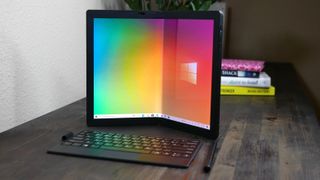
What's more problematic than any creasing is the panel's glossy finish. The plastic shimmers against any light source, so although it gets bright and has unrivaled contrast, using the ThinkPad X1 Fold outside under the Texas sun wasn't ideal. I could still see the beautiful colors, and webpages were still legible, but my portrait was staring right back at me from the glossy laminated layer.
According to our colorimeter, the X1 Fold's display covers 104% of the DCI-P3 color gamut, making it much more colorful than the panels on the XPS 13 (81%), Surface Pro 7 (69%), the iPad Pro (87%) and the category average (86%).
As gorgeous as it is, the OLED display doesn't get very bright, reaching only 301 nits. The XPS 13 (469 nits), iPad Pro (559 nits) and Surface Pro 7 (395 nits) all outshone the Lenovo, which didn't even reach the 387-nit average.
Lenovo ThinkPad X1 Fold audio
Dual speakers are positioned on the front cover, or on the left edge when opened in the horizontal orientation. They sound fine, but I hope the next model includes an opposite pair for a quad setup.

The X1 Fold was fine for listening to soccer commentary, but you'll want a Bluetooth speaker when jamming to your favorite tunes. Ben Howard's live performance of "Empty Corridors" sounded thin and frail on the X1 Fold. The vocals and acoustic guitar picking were airy, but there was an annoying fuzziness when the vocals overlapped the instrumentation.
Jessie Reyez & 6LACK's "IMPORTED" sounded better, but didn't have the depth I needed for chest-thumping bass or toe-tapping rhythms. And when I jammed out to Leisure's "Nobody (feat. Gold Link)," the chorus was blanketed at maximum volumes. The speakers get loud enough to fill a small room, but you won't be dancing at a party to this tablet.
Lenovo ThinkPad X1 Fold keyboard and touchpad
I can't stand on-screen keyboards. You have to pray they pop-up at the right times then awkwardly tap away at a vertical piece of glass (or plastic, in this case).
Fortunately, Lenovo created a custom keyboard just for this device called the Fold Mini Keyboard. There are lots of pros and cons, but overall, it's a useful accessory that could use some fine-tuning.
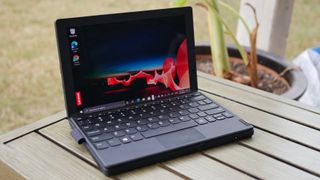
I'll start with the good, and that's how the keyboard enables the X1 Fold to be used as a laptop. Cleverly placed magnets allow the keyboard to remain suspended on one half of the screen while the other acts as a primary display when the system is folded at a 90-degree angle. The hinge is strong enough that you don't need to use the kickstand to keep the display portion from falling down.
Moreover, the keyboard nests nicely inside the folded tablet, filling the gap between both displays while wirelessly charging its battery. When you want to use the full 13.3-inch display, you can detach the Fold Mini from the screen and use it as a regular Bluetooth keyboard. Pairing the keyboard to the X1 Fold is effortless, and the keys themselves have a pleasant clickyness.
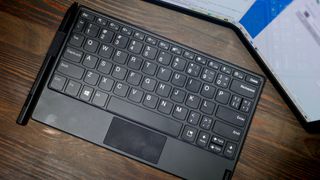
Now for the not-so-good. Naturally, the keyboard is small and will feel cramped if you have larger hands. Also, there are a few undersized keys and, as you might expect, no backlighting. The biggest offense of all? The keyboard is sold separately for $299. Ouch. It's an insult to injury for a tablet that'll already run you $2,500.
And then there's the touchpad. It's cute, but not so practical. The miniature rectangle has room for only two fingers, making it tricky to use for anything beyond moving the cursor. And while the smooth, soft-touch material feels great and even responds quickly, there's no point in trying any fancy Windows 10 gestures.
Lenovo ThinkPad X1 Fold Mod Pen
The other custom-build accessory sold alongside (not included with) the ThinkPad X1 Fold is the Mode Pen. Yep, Lenovo (unlike Samsung) figured out stylus support on a flexible display. The pen is comfortable to hold, but I had trouble drawing straight lines in 3D Paint.
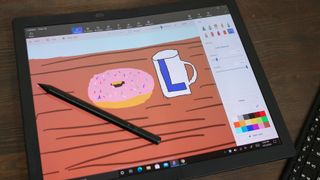
I'm not sure if it was my own artistic deficiencies (of which there is no end) or the imperfectly flat screen. Regardless, a drawing of my morning doughnut and cup of Joe had jagged edges and unintentionally squiggly lines. On a positive note, the pen, which uses Wacom's protocol, kept up with my movements and supports tilt for different line widths.
On the side of the stylus are two buttons that can be customized in the Lenovo Pen Settings app. I kept the bottom button as a quick way to get to the eraser (a tool I used quite often) and the top button for undo (which I needed equally as often).
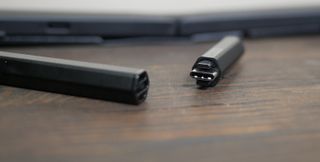
Removing the cap reveals a USB-C charging port, which gets you 250 minutes of use from 15 minutes of charge or a month of drawing from a 2-hour charge. When you're done using the Mod Pen, a loop in the keyboard accessory acts as a useful storage spot. I wish the loop were on the actual tablet (where it was on prototypes we tested) but at least there's a place to store it.
Lenovo ThinkPad X1 Fold modes and switcher
Lenovo sees the ThinkPad X1 Fold as being capable of replacing not just your tablet, but also your laptop.
You can use the X1 Fold as a standard tablet with the device unfolded entirely and the screen stretched flat. If you're reading a book or multiple documents, you can bend the X1 Fold to create a left and right half.

Of course, to get the most out of the flexible screen, you'll need the keyboard. The obvious setup is having the X1 Fold propped up with the kickstand while in tablet mode with the external keyboard placed in front of it.
As previously explained, the X1 Fold uses clever software and strategically placed magnets to recognize when the keyboard is placed on top of the lower half of the screen. In this position, content gets pushed to the top screen and you can use the X1 Fold as a laptop. Again, this cuts your precious display real estate in half, so it feels similar to using a netbook.
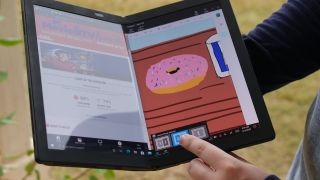
Helping you stay productive in each of these modes is Lenovo's custom Mode Switcher software. It works similar to the split-screen feature in Windows 10, except that it recognizes the fold in the center of the screen and considers each half a separate display. This way, you can place one window on the top half and another on the bottom, or one on the right and the second on the left.
Mode Switcher worked well in my testing. I received a prompt the moment I started folding the display that let me choose my preferred layout. I went with my camera app on the right and Paint 3D on the left. When I rotated the tablet, the windows adjusted accordingly with 3D Paint moving to the top and my mugshot dropping below.
You don't need to bend the X1 Fold to use the Mode Switcher — tapping a small icon on your toolbar brings up the prompt.
Lenovo ThinkPad X1 Fold performance
What is an Intel Core i5-L16G7 CPU, you might ask? The most premium of Intel's Lakefield family, this chip is the smallest x86 processor around. A hybrid chip, it uses a unique "Foveros 3D stacking" technique that stacks two logical dies and two layers of DRAM. Doing the heavy lifting is a single 10-nanometer core while four low-power cores work in the background for efficiency during less intensive tasks.
The goal? Give the X1 Fold enough performance to run multiple apps, but with an efficient chip that ensures the tablet can deliver long battery life. In practice, the Core i5-L16G7 does reasonably well with performance, but struggles with endurance.

The X1 Fold, paired with 8GB of RAM did a good job in my real-world testing. I loaded two dozen RAM-hungry Google Chrome tabs, two of which streamed Twitch videos while another pair played YouTube clips. The tablet didn't freeze or crash, even when I loaded 10 more home listings during my impossible search to buy my first home. Graphics and text took a few extra measures to fully render, but I was pleased with the performance.
More annoying than how slowly some apps loaded was the sluggishness of Windows 10 Pro. Switching from portrait to landscape mode takes a full 3 seconds, and I found that the display occasionally defaulted to portrait mode even when I was holding it horizontally. I also noticed some screen flickering and the infrequent but infuriating bug when pulling up the search bar or Start Menu. There were times when I couldn't click on my app's toolbar to exit out or downsize it, and at one point, the Mode Switcher put two apps I had open in a small window in the middle of the screen instead of splitting them on each side (see the above photo). I can't attribute all of these faults to the X1 Fold, but they sour an otherwise satisfying experience.
While it's faster than previous Y-series CPUs we've tested in the past, the Core i5-L16G7 CPU is no match for U-series processors in today's top laptops or the A-series chips in Apple's slates. The X1 Fold scored a 1,794 on the Geekbench 5 overall performance test, coming nowhere near the XPS 13 (5,254, Intel Core i7-1165G7), Surface Pro 7 (4,443, Intel Core i5-1035G4), iPad Pro (4,720, A12Z) and the category average (4,102).
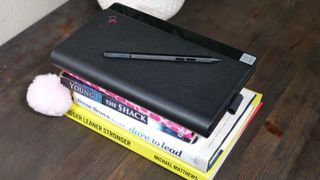
That subpar score translated to our video transcoding test in which the X1 Fold needed 33 minutes and 31 seconds to convert a 4K video to 1080p resolution. XPS 13 (18:22) owners can almost accomplish that task twice in the same amount of time, while the category average (17:38) is even faster than the Dell. For what it's worth, the Surface Pro 7 (32:47) also struggled on this benchmark.
Lenovo outfit the X1 Fold with a relatively speedy 256GB SSD, which duplicated a 5GB multimedia file in 11 seconds at a rate of 444.6 megabytes per second. That outpaces the Surface Pro 7 (267.9 MBps, 256GB SSD) but lags behind the XPS 13 (729.3 MBps, 512GB M.2 PCIe NVMe SSD) and the average (810.4 MBps).
Lenovo ThinkPad X1 Fold graphics
As you might have guessed, you won't be playing any AAA games on the ThinkPad X1 Fold. Apps will run fine but gamers will want a proper gaming laptop or console to play Cyberpunk 2077 whenever it finally arrives.
We struggled to run Sid Meier's Civilization VI: Gathering Storm (1080p, Medium) on the X1 Fold, which puttered at a glitchy 9 frames per second. The XPS 13 played the same game at 55 fps, which is much smoother than the 27 fps average.
In our synthetic benchmark test, the X1 Fold reached a 3D Mark Fire Strike score of 1,184, well below the XPS 13 (2,837) and the premium laptop average (4,120).
Lenovo ThinkPad X1 Fold battery life
When it comes to battery life, the X1 Fold has a lot going against it. OLED display? Yes. Thin, compact form factor? Yes. Full Windows 10? Yes.

So when the X1 Fold lasted for 6 hours and 3 minutes on our battery test, I wasn't surprised although I can't say I wasn't a bit disappointed. Even the Surface Pro 7 (7:30) lasted longer on a charge while the iPad Pro (10:16) and Dell XPS 13 (12:39) stayed powered for several additional hours.
Lenovo ThinkPad X1 Fold webcam
There are no rear-facing cameras on the X1 Fold, only a 5-megapixel camera for selfies and video conferencing.

It's the same ol' story with this camera. In less-than-ideal lighting, photos and videos look poor. Move to a well-lit environment and things drastically improve. I took two selfies on the same day. One taken under normal lighting conditions has a layer of visual noise and obscures my beard into a singular blog. The other (see above image), taken near a window on a sunny day, looks much more clear and captures individual hairs (I know, this quarantine hasn't been kind to me). For what it's worth, the colors are good in both shots.
Lenovo ThinkPad X1 Fold software and warranty
Beyond the Mode Switcher and Pen Settings apps, the X1 Fold comes with a few Lenovo-branded tools.
Commercial Vantage is where you'll get the latest driver and BIOS updates along with support, system health and warranty info. It's a visually pleasing one-stop-shop utility software. There is also a display optimizer app that lets you adjust the panel to different presets (native, standard, Photo Pro, Movie Pro, Blue Light Cut) and pair apps to custom display settings. It's a great tool for photo or video editing.
Lenovo Camera Settings is pretty self-explanatory. It's a basic app that lets you change the orientation of your camera preview and enable noise reduction software in low light (the results are nothing to write home about). And lastly, Lenovo Voice is a voice translator that did a solid job of translating my rusty German into English.
Lenovo ships the X1 Fold with a one-year warranty. See how the company fared in our Best and Worst Laptop Brands and Tech Support Showdown special reports.
Bottom line
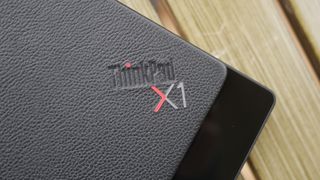
This was always going to be a tough product to judge. I really like having the ThinkPad X1 Fold around. Its small form factor doesn't take up much space and the gorgeous OLED panel beautifully showcased my favorite shows and movies. Also, the excellent build quality, crafted with a mix of high-end materials, earns Lenovo some hearty applause.
But as much as I would love to own the X1 Fold, I have a hard time recommending it. While the X1 Fold works well as a tablet, I can't justify spending $2,500 on a device with so many shortcomings as a laptop replacement. Battery life, at 6 hours, is a major setback, software quirks get in the way of productivity, and the X1 Fold's performance can't compete with other laptops in this price range.
Speaking of price, the ThinkPad X1 Fold is extremely expensive. I don't blame Lenovo — this is simply a consequence of being a first-gen product — but the vast majority of customers won't look past the $2,500 asking price. What I do blame the company for is charging extra for the stylus and keyboard, both of which are necessary if you want the Fold as your primary computing device.
Given these gripes, the ThinkPad X1 Fold isn't practical for most people. Rather, it's a device I can see CEOs flaunting in board meetings. And the few people who do buy this PC will probably really enjoy using it. Throughout my time with the X1 Fold, I struggled to answer the question: "Does this even work as a concept?" Well, the growing dread I feel about having to ship this back to Lenovo says a lot, and I'm eager to see what comes next.
Phillip Tracy is the assistant managing editor at Laptop Mag where he reviews laptops, phones and other gadgets while covering the latest industry news. After graduating with a journalism degree from the University of Texas at Austin, Phillip became a tech reporter at the Daily Dot. There, he wrote reviews for a range of gadgets and covered everything from social media trends to cybersecurity. Prior to that, he wrote for RCR Wireless News covering 5G and IoT. When he's not tinkering with devices, you can find Phillip playing video games, reading, traveling or watching soccer.
